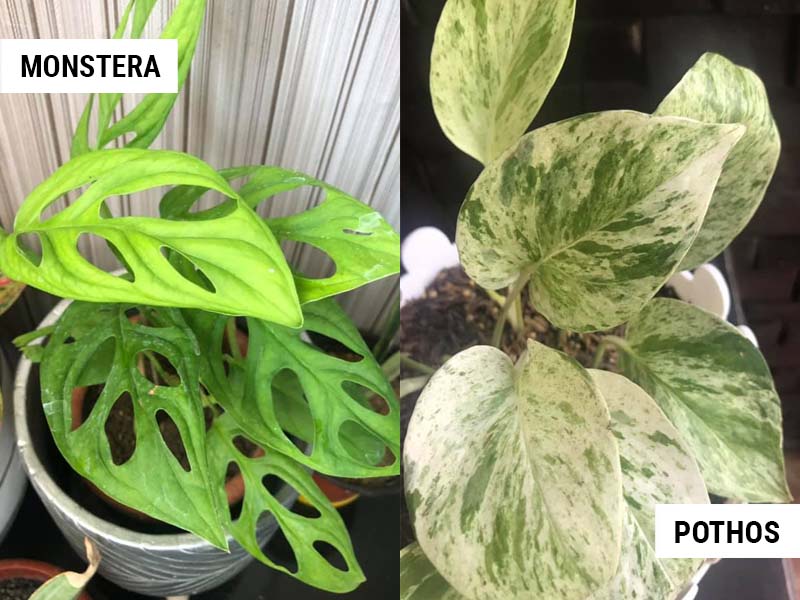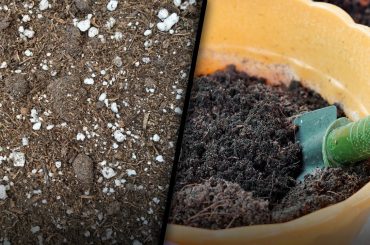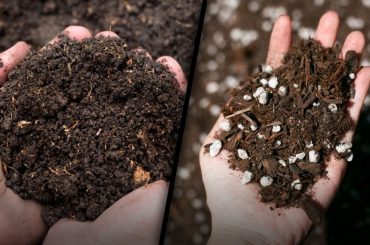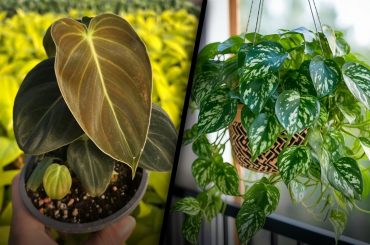Monstera and pothos plants are popular indoor houseplants among houseplant enthusiasts more than ever before. As compared to other similar houseplants on the market today, their leaves are attractive due to their beauty and originality. In spite of what may seem like there is competition between these plants, they are completely distinct species that are able to coexist in the same area due to the similar care they require.
A monstera plant and a pothos plant are characterized by their leaf sizes. Monstera leaves are massive, whereas pothos leaves are relatively small. Species will vary in size naturally, but overall, there is a noticeable difference in leaf size between them. Moreover, monstera plants have bushier forms and stems with long, leafy leaves. Pothos prefers to climb along surfaces like vines.
Here are the biggest differences and similarities between these two houseplant powerhouses. As a bonus, we will also provide you with some helpful tips for deciding which plant you should grow in your home, according to your time constraints.
The Key Differences Between Pothos and Monstera
It is the size of these plants that determines the main difference between them. Known for their large leaves, monstera plants have a distinct appearance. Pothos prefers to climb and vine, while monstera prefers to grow bushier.
As well as these key differences, there are others. There are some specimens in the wild that grow as tall as 70 feet! The monstera plant grows significantly larger or taller than the pothos plant at about seven to 66 feet tall. A pothos plant can reach a height of up to 40 feet at most, however.
The differences between these plants are also complemented by many similarities. USDA hardiness zones 11 through 12 and temperatures between 65 and 75 degrees F are suitable for both. Despite their significant differences in height, they both grow to a maximum mature width of between two and six feet. Their growth rates can vary greatly depending on their care, from quite slow to quite fast. Besides requiring bright, indirect sunlight, monstera and pothos also prefer well-draining, aerated soil with a pH of around 6.0. They also require similar watering requirements as well as being susceptible to fungal diseases and mites.

Pothos vs. Monstera: Classification
Epipremnum aureum is the botanical name for pothos plants. The plant belongs to the Araceae family and is a member of the Pothos genus. There is a Monstera delicious classification for Monstera plants. Like pothos, they belong to the Araceae plant family and are members of the Monstera genus. There is a common family connection between these two plants, which are both tropical plants. Among its relatives are taro, skunk cabbage, calla lilies, monstera plants, and taro trees.
Pothos vs. Monstera: Description
Epipremnum aureum or golden pothos, which is native to Solomon Islands, is a climbing, trailing vine with golden to pale green veins and white variegation on its leaves. Growing up to 40 feet long and climbing trees through aerial rootlets (roots that do not grow in soil), the pothos plant is naturally found in southeastern Asia. Besides being a ground cover, it also acts as one in the wild.
Leaves on young plants are shaped like heart shapes, waxy, green, and variable in color from yellow to white. Large, mature vines, on the other hand, have much larger leaves with deeper lobes (up to 30 inches). Because the plants are closely related, they have philodendron-like characteristics. Children and pets are poisoned if this plant is consumed. A mature pothos plant typically bears small berries following small blooms. Usually, indoor plants do not produce flowers or berries.
In addition to its native Central America, Monstera delicious is also called Swiss cheese plant, split-leaf philodendron, or philodendron with split leaves. In addition to its long aerial roots that resemble ropes, it also has enormous holes on its thick leaves, making it an evergreen perennial shrub or vine. A 1 to 3 foot long leaf will cover the trunk of a tree with impressive growth that can reach 70 feet in its native tropical habitat. Six to eight feet is the normal height for indoor plants.
Unlike many other plants, it produces large, lustrous, deep green leaves that are sliced and perforated. In young leaves, the signature “sliced” appearance is often missing. Mature monstera plants produce white spathes with an arum-like spadix. There is an edible fruit that tastes like pineapple and banana and is born from flowers. Pothos, like indoor plants, rarely bears fruit or flowers. Plants can receive nutrition from the ground by rooting their lower aerial roots. Cut off or tie a climbing pole to the aerial roots on the plant’s higher portions.
Pothos vs. Monstera: Uses
As a beginner-friendly houseplant, pothos are a great choice. Despite its robust nature, pothos is quite tolerant of neglect and thrives in poor conditions. Aside from removing unpleasant odors, these plants are also instrumental in eliminating formaldehyde, benzene, and carbon monoxide from the air. People who work at screens all day can benefit from pothos as well.
Decorative houseplants are the main purpose of monsteras. Outdoor plants such as this are quite common in some places. It also cleans and improves air humidity like pothos. If the fruit is not fully ripe, it can be toxic to consume, as it is low in fat, high in protein, and high in calcium and phosphorus. Other health issues, such as arthritis and insect stings, can also be treated with monstera.
Pothos vs. Monstera: Origin
Southeastern Asia is the home of pothos plants. French Polynesia has also found them on its islands. As well as New Guinea and Australia, some pothos species are found there.
Central America is home to Monstera plants. From central and southern Mexico to Panama, you’ll find them abundantly in tropical forests. There have been a number of instances of it becoming invasive since it was discovered, such as in Hawaii and the Society Islands.
Pothos vs. Monstera: How to Grow
The pothos plant is relatively easy to grow indoors with little maintenance required. Pothos doesn’t have a specific preference when it comes to potting soil, but it thrives in nutrient-rich soil. Most pothos varieties prefer indirect, bright sunlight, despite the fact that they may tolerate low lighting. A sunny window is best, but you should not place it right in front of it, since too much sunlight can burn the leaves. Despite its inability to handle very wet soil, the pothos plant loves water when it can get it, so water it well at least once a week when possible. A monthly fertilization treatment is preferable for pothos plants. The vines will grow stronger and have lush, deep green leaves as a result.
Growing Monstera plants is similar to growing other plants. Indoor monstera plants may reach a height of 10 feet or more with a balanced fertilizer applied three or four times a year. In the case that it is intended to be used as a houseplant, you’ll want to choose a deep container that has plenty of drainage holes. A consistent temperature of 65 to 75 degrees F is required for this evergreen plant to thrive. Its leaves will burn in the summer months if they are exposed to too much direct sunlight. Growing Monstera in a pot requires potting soil based on peat. For monstera plants to thrive outdoors, you can use sand, loam, and heavy clay soil that has an acidic or neutral pH.
Pothos vs. Monstera: Special Features
In some Southeast Asian nations, including the Indian subcontinent, China, Taiwan, Thailand, and some others, the pothos plant is referred to as a “money plant.” This plant is thought to bring good fortune, good fortune, and money to the owner.
The wild fruit of Monstera delicious is very flavorful. Although the fruit itself has quite a unique flavor, it combines strawberry, mango, and pineapple flavors. The fruit of the Monstera delicious tree is so delicious that it gets its name.
Due to its virtually unkillable nature, pothos is called “devil’s ivy.”. This plant thrives in low light levels, which are extremely rare among plants. Despite its frequent inclusion on lists of “no light” plants, the pothos does require the presence of some sunlight to thrive.
Tropical rainforests of Central America are the native environment of the monstera. Having holes in monstera leaves allows the elements and even debris to pass through without harming it, so the enormous leaves can survive strong winds and rain.
In spite of the differences between pothos and monstera, both plants are popular houseplants. Both can grow to quite large sizes and are very showy, making them ideal as centerpieces in any home. Growing them together is also quite easy since they have similar growth requirements. To create a tropical, relaxing environment in your home, why not plant both of these?





